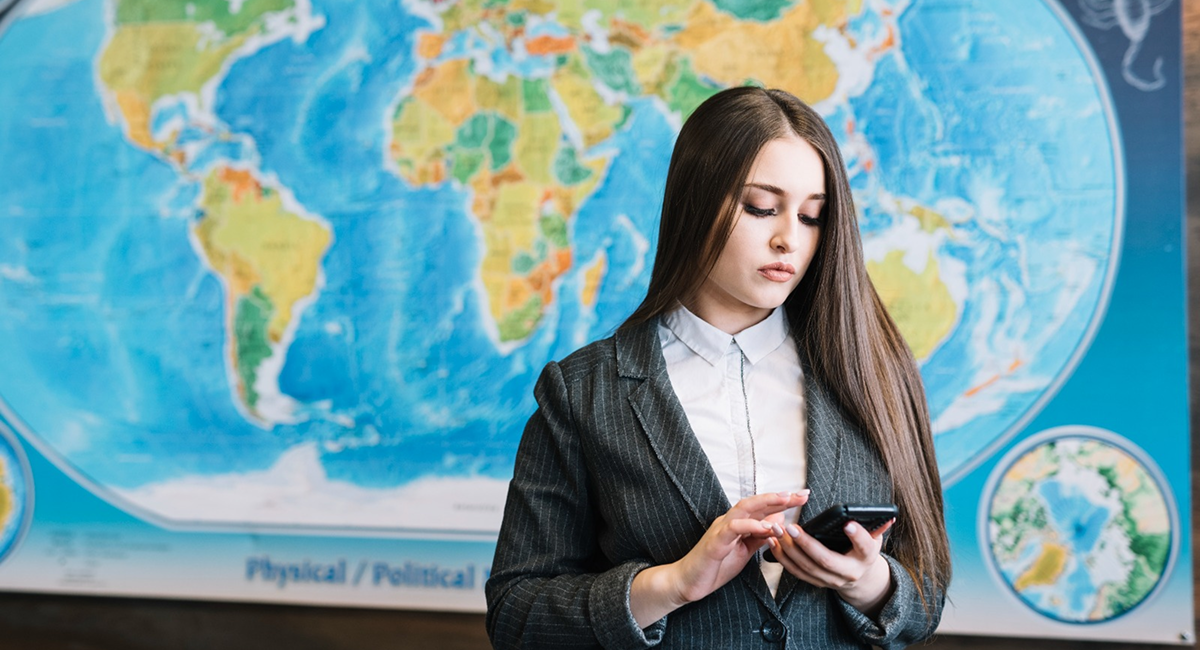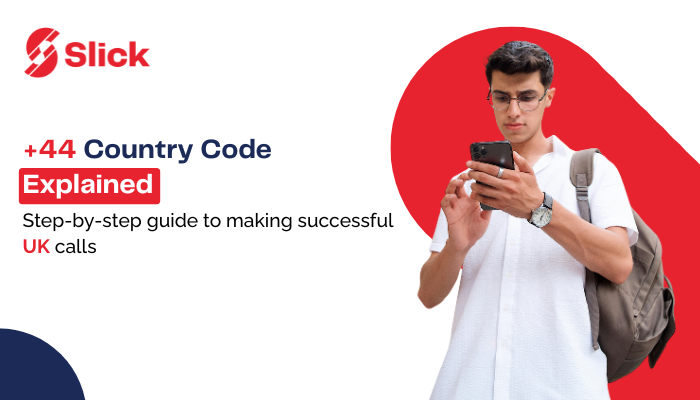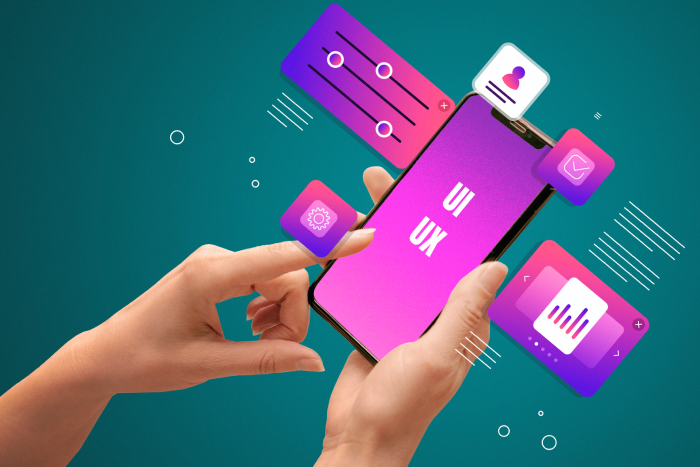Ever feel like calling someone overseas is way harder than it should be? You dial the number and double-check the code, but the call still doesn’t go through, or worse, you get hit with random fees. It’s frustrating, especially when all you want is a simple chat with someone across the globe. Let’s face it: staying connected internationally shouldn’t feel like solving a puzzle. The good news? It doesn’t have to be that way. Most calling issues come down to small oversights like using the wrong format or relying on low-quality apps. But once you know the best cheap international call tips, calling abroad becomes smoother. That’s exactly why we put together these best practices for international calling. With a little help from Slick, you can skip the guesswork, avoid surprise costs, and enjoy clearer, more reliable calls. So, what’s the first thing to check before dialling? Let’s look at that next.
8 Best Practices for International Calling to Save Money and Stay Connected
1. Use a Reliable App to Avoid Call Drops
A lot of people rely on apps like WhatsApp or FaceTime to make international calls. But here’s the catch: both users need to be online and use the same app. So what happens if the person you’re calling isn’t tech-savvy or doesn’t have a stable internet? That’s when those apps fall short. For example, let’s say you’re trying to call your grandma in a rural town. She doesn’t use smartphones and isn’t downloading international calling apps. Now what? This is where your choice of app makes a real difference.
What’s the Better Option?
Instead of limiting yourself to internet-only services, go for full-featured calling apps. These let you call any number directly, mobile or landline, even if the other person isn’t online or using the same app. That’s why one of the most overlooked yet practical VoIP best practices is this: always pick a calling app that works like a real phone service. Slick is a solid example of this approach. You simply dial, and your call connects. No internet is needed on the other end, and there is no setup for the person you’re calling. It just works, which can save you a lot of frustration.
So, when you’re reviewing the best practices for international calling, think beyond Wi-Fi and app-to-app communication. Go with tools that mirror traditional phone calls but still save you money. Up next, let’s look at another smart upgrade that travellers and frequent callers love: eSIMs.
2. Activate an eSIM Instead of Paying High Roaming Fees
Traditional Roaming Costs You More Than You Think
Roaming charges can sneak up on you fast, and they’re rarely kind to your wallet. Instead of sticking with your home carrier and getting hit with sky-high fees, getting a travel-friendly eSIM is smarter. It lets you tap into local data networks at local prices, plus you don’t need to deal with swapping physical SIM cards. But here’s the real kicker: you can install and activate it straight from your phone in just a few taps. It’s quick, easy, and saves you from unnecessary costs while abroad.
Real-Life Scenario: The Arrival Stress Test
Picture this: you’ve just landed in a new country, you’re jet-lagged, and suddenly you need to call your Airbnb host. But your mobile data? Down. No signal, no help. This is where an eSIM truly shines. With an eSIM, you don’t need to search for a SIM card store or mess with tiny trays. You’re online instantly, ready to call, message, or book that Uber. Isn’t it better to have peace of mind before you even leave the airport?
How Does Slick Make It Simple?
Thankfully, Slick has built-in travel eSIM options right in the app. You can browse, purchase, and activate international data plans without leaving your screen. There’s no guesswork, no surprise charges, and absolutely no need to overpay for roaming. Just a few taps, and you’re good to go. So, if you’re serious about following the best practices for international calling, getting an eSIM should be at the top of your list. Now that you’re equipped with smarter ways to stay connected, let’s look at another crucial tip: how to save international contacts properly so your calls go through without a hitch.
3. Save All Contacts in International Format
Formatting your contacts using the international dialling format ensures that calls go through regardless of where you are or what network you’re using. It’s a small step that prevents a lot of failed call attempts. For example, instead of saving a number in Nigeria as 08012345678, save it as +2348012345678. That way, whether you’re in Lagos or London, your device and apps will dial correctly. It also prevents confusion if you switch SIM cards or phone numbers. Your contacts will remain globally dialable. Many calling apps automatically detect the format, but having the right structure ensures smooth calling across borders. Slick’s dialer handles international formats smartly, so even if you forget the right code, it often corrects or suggests the correct number.
Slick Makes it Even Easier
The Slick app’s smart dialer recognizes most international formats. So, even if you forget a country code, it often fills in the blanks or gives you a quick fix. That’s why this small habit, when paired with a smart app like Slick, keeps your international calling smooth and reliable. So, now that you know how formatting can make or break your call, let’s move on to the sneaky challenge of VoIP restrictions.
4. Monitor Your Data Usage—Especially for Video Calls
If you’re using mobile data while abroad, video calls can be sneaky data hogs. For example, a quick video chat with family can turn into a surprise data drain. That’s because, unlike voice calls, video eats up a lot more bandwidth. So, if you’re not on an unlimited plan, it’s easy to burn through your allowance way faster than expected. Let’s break it down in simple terms.
A 1-minute voice call usually takes up around 0.5 MB, while a 1-minute HD video call can use 5 to 10 MB. So, if you’re on a 1GB plan and make a one-hour video call, you could use up 600 MB just like that. That’s over half your data gone in a single conversation. Now, here’s a practical workaround. Stick to voice calls when video isn’t necessary. Even better, make sure your data plan is suited for international use, something that can handle the load.
Use a Data Plan Made for Global Calling
The smarter move? Pair a reliable international data plan with a calling app that’s optimized to use less data. This is where Slick steps in. With affordable data through travel eSIMs, Slick helps you save data without lowering your call quality. It’s one of the best practices for international calling that can make a difference when you’re travelling. Think about it: why use five times more data when a voice call gets the message across?
It all comes down to using tools that make your data work smarter. That’s why choosing apps and plans designed for global usage isn’t just convenient; it’s essential. Following this kind of approach is one of the most underrated best practices for international calling. But what if your internet drops mid-call or your app fails to connect? That’s exactly why the next tip is all about always having a backup calling option ready.
5. Always Have a Backup Calling Option
Why Do You Need a Plan B When Calling Internationally?
Wi-Fi can suddenly cut out, apps can freeze, and calls might drop for no obvious reason. That’s why one of the most important best practices for international calling is having a backup option in place.
What does that look like in real life?
Imagine this: You’re on a critical call with a client overseas. Everything’s smooth until, bam, the connection crashes mid-sentence. If you don’t have a backup, you’re stuck trying to troubleshoot under pressure. Instead, if you’re using a service that offers both app-based calling and offline calling, you can reconnect almost instantly. Having a platform that handles both VoIP and traditional calling is like having a spare tyre. You hope you won’t need it, but when you do, it saves you from major headaches.
A Smart Solution That Covers Both VoIP & Traditional Calling
Slick is built exactly for this kind of reliability. It offers online and offline calling services. So, your conversation keeps going even if your Wi-Fi doesn’t. Using tools like this is one of the best practices for international calling, especially if your work or personal life depends on reliable connections. In short, don’t just hope for the best; plan for the worst. Having a reliable backup is a small move that makes a big difference. Next, let’s talk about something equally important—why you should think twice before connecting to public Wi-Fi.
6. Avoid Public Wi-Fi Without a VPN
Public Wi-Fi feels convenient—But is it Worth the Risk?
Picture this: you’re at an airport café, sipping coffee and jumping on a quick call over public Wi-Fi. But that same free network is open to everyone, including hackers. In other words, public Wi-Fi might save you a little data, but it could cost you your privacy. This is especially risky if you’re making VoIP calls or discussing anything sensitive.
Why are Public Networks a Hotspot for Trouble?
Surprisingly, places like airports, hotels, and cafés are goldmines for cybercriminals. People assume those Wi-Fi networks are secure just because they’re widely used. But in reality, these open networks are easy targets for hackers to intercept your call data or even spy on your connection. If you’re not using encryption, your conversations could be exposed. Think about it: Would you hand your phone to a stranger and ask them to listen? That’s pretty much what happens when you call over an unsecured Wi-Fi.
What’s the Safer Way to Stay Connected?
Instead of gambling on open networks, take a smarter route. Use a trusted encryption service whenever you’re on public Wi-Fi. It encrypts your internet traffic and adds a much-needed layer of security. Even better, skip the Wi-Fi risk altogether by switching to mobile data. A reliable eSIM plan or personal hotspot can make a huge difference.
Slick’s eSIM data plans are a practical solution here. They let you access secure, high-speed data without needing to connect to public networks. It means smoother, safer calls, especially when you’re far from home. So, if you’re following the best practices for international calling, safeguarding your connection should be right at the top of your checklist. After all, call quality means nothing if your privacy is at stake. Next up, let’s explore how to choose the right apps that make international calling not just safer but smarter, too.
7. Pick an App That Supports Instant Mobile Top-Ups
Why This Matters More Than You Think
Ever tried calling a friend abroad only to hear the line go dead or not connect at all? Chances are, it wasn’t your network. It was probably them running out of balance. In many countries, prepaid phones are still super common. That means when your cousin or best friend runs out of credit, they simply can’t answer even if they want to.
A Quick Fix That Works
Instead of waiting for them to recharge, why not take the lead? Choosing a calling app that lets you send instant mobile top-ups is one of the best practices for international calling. It keeps conversations going and avoids unnecessary delays. For example, say your sibling in Nigeria is running low on credit. You’re trying to finalize weekend travel plans, but they’re offline. With Slick, you can send a mobile top-up in seconds and get the conversation flowing again. Isn’t that way more efficient than playing phone tag?
Slick Makes It Easy
Slick supports mobile top-ups in over 150 countries. You just enter the number, choose the amount, and hit send. It’s done in seconds, with no need for multiple apps or complicated steps. That’s why, if you’re serious about staying connected, this should be part of your go-to routine.
Including mobile credit sharing in your toolkit is one of those overlooked but best practices for international calling that saves time and keeps your connections strong. Up next, let’s talk about saving emergency numbers abroad because staying prepared is just as important as staying connected.
8. Save Local Emergency and Embassy Numbers
What If Something Goes Wrong While You’re Abroad?
It’s not the kind of question anyone wants to think about, but it’s an important one. That’s why, before you focus on the best practices for international calling, you should first make sure you know who to call in an emergency. Just like you wouldn’t drive without a spare tyre, you shouldn’t travel without saving key contact numbers.
Which Contacts Should You Save?
Here’s a quick list of what to save:
- Local emergency services (like ambulance, fire, or police)
- Your country’s nearest embassy or consulate
- Your travel insurance’s 24/7 emergency number
Plus, don’t just save these to your phone; also write them down somewhere safe, like in your wallet or passport holder. If your phone dies or gets stolen, that backup list might be your lifeline.
Make Those Numbers Easy to Find
It’s not enough to just have them. Instead, make sure these numbers are marked as favorites in your phone so you’re not fumbling through contacts during a crisis. For example, label them clearly, like “Travel Emergency” or “US Embassy – Tokyo.” Apps like Slick make this even easier. You can save crucial international numbers, including emergency contacts, in the app and pull them up in seconds. That’s one of the simplest best practices for international calling that can save you time and stress when it matters most. In short, if your phone is your travel companion, your emergency numbers are the safety net it needs.
Final Thoughts
International calling doesn’t have to be a headache or cost a fortune. With just a bit of planning, you can stay in touch from almost anywhere without breaking the bank. So, what’s the trick? Choose apps like Slick that offer everything in one place: eSIM data, direct calling, mobile top-ups, and call credit tracking. That’s how you follow the best practices for international calling. Slick does exactly that. When you stick to these best practices for international calling, staying connected feels easy.



